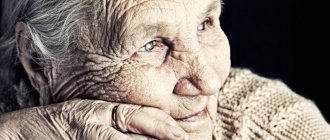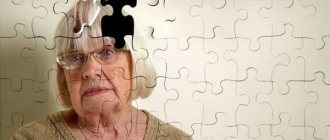Dementia: stages of development, prognosis and life expectancy
Dementia literally means madness in Latin. In the everyday sense, words denoting a decrease in mental abilities and memory - insanity, dementia - are considered synonymous. This is an acquired condition that occurs due to the breakdown of mental functions. The disease is most common in older people.
You can often hear the common expression “senile insanity,” which is also synonymous. Dementia in older people requires timely seeking professional help. Treatment started in the early stages will help correct behavioral abnormalities, saving both the patient and relatives from serious problems.
Dementia. What it is?
The disease implies an acquired form of dementia, characterized by a consistent decline in thinking and memory. Its manifestations, as practice shows, are very diverse. Initially, the patient loses previously acquired professional skills, thinking becomes illogical, and the former interest in life disappears. In especially serious cases, a person is not able to realize what is really happening to him, where exactly he is, and ceases to recognize his loved ones. In a word, he needs constant care.
According to available WHO data, global incidence rates currently number approximately 35.5 million people with this diagnosis. This figure is expected to rise to 65.7 million by 2030 and to 115.4 million by 2050.
Diagnosis of dementia
In small towns, a referral to a dementologist is prescribed by a therapist. To establish a diagnosis, the doctor asks the patient questions about time and space. What time of year is it now? What city is he in now? Based on the answers, he determines the diagnosis.
Relatives can also determine the diagnosis using a simple test. You need to ask an old man to draw a dial with a certain time. A healthy person will draw the dial correctly. And the patient will draw extra numbers and indicate the appointed time incorrectly.
Causes of the disease
Dementia in older people in 90% of cases occurs due to the death of neurons directly in the brain itself, which is closely related to a deficiency of vascular nutrition and toxic complications. In 10% of cases, so-called secondary dementia develops against the background of other somatic diseases, leading to difficulty in the functioning of the central nervous system.
The disease can manifest itself not only in old age, but also in young people - due to mechanical damage, brain diseases, and exposure to toxins.
What should I do?
You need to sound the alarm after detecting 3-5 signs of dementia. Specialist assistance should be immediate.
Please contact:
- therapist;
- neurologist;
- psychiatrist;
- geriatrician
Identifying Early Symptoms
The SAGE test is carried out.
The main task is to identify moderate disorders of thinking and memory.
The instructions look like this:
- “Arm yourself” with a pen.
- Complete the tasks on the form provided.
- Count the number of points.
Note! You cannot use a watch or calendar during the test.
10-15 minutes are allotted to complete the task. If the patient scores less than 14 points, this indicates severe cognitive impairment.
The most effective tests
The table presents the most informative tests for dementia in the elderly.
Table 7. Best tests.
| Test name | Description | Time spending |
Dementia test Mini-Cog. | Assessment of visual-spatial coordination and short-term memory. | 3-5 min. |
KSHOPS. | This is a detailed test that allows you to assess the patient’s mental status, orientation in time and space, memory, speech, perception and concentration. | 5-10 min. |
BPD. | Allows detection of frontal lobe dementia. | 5-15 min. |
Pathologies leading to the development of dementia
- Traumatic brain injuries.
- Neuroinfections (Creutzfeldt disease, HIV, multiple sclerosis).
- Neoplasms, including malignant ones.
- Vascular pathologies.
- Intoxication of the body with drugs, heavy metal compounds.
- Disturbances at the level of metabolic processes (hypoxemia, hypoglycemia, deficiency of B vitamins, folic acid).
- Diseases of the central nervous system in which death of brain cells is observed (Alzheimer's syndrome, Parkinson's syndrome, Huntington's chorea).
Risk factors
- Age. The older a person is, the higher the likelihood of developing a disease such as dementia. How many years do patients live? It is very difficult to answer this question unambiguously. Typically, death occurs approximately six years after the onset of initial symptoms.
- Floor. Representatives of the fair sex are several times more likely to be diagnosed with Alzheimer's disease. This is thought to be due to a lack of estrogen during menopause. The vascular form of dementia, on the contrary, predominantly occurs in men. They are much more likely to have heart problems and increased blood pressure.
- Genetic predisposition. Scientists have proven that Alzheimer's disease can be inherited.
Late symptoms of senile dementia
As dementia progresses, symptoms become more severe. They allow specialists to establish an accurate diagnosis and determine the stage of development.
Amnestic phenomena
Memory impairment manifests itself in patients in different ways. They forget the purpose for which they go to this or that room, but do not take it seriously, considering it ordinary forgetfulness. Moreover, similar signs are observed in women who are under 65 years of age. Time orientation is greatly impaired. The patient remembers the present date for a long time, and is also unable to recognize places familiar from childhood.
Later, amnestic phenomena associated with the inability to remember faces appear. Even after several meetings and conversations with a person, a woman cannot remember him. Such a symptom should be a cause for concern.
At an advanced stage, the patient forgets the faces of relatives, and also cannot recognize her own reflection in the mirror. It is worth noting that changes occur gradually, progression takes from 15 to 20 years. When using memory enhancing products, this period increases.
Decreased mental activity
Impairment of speech and simple thought processes always accompanies dementia. At the initial stage, this is not so noticeable, but as the condition progresses, the symptoms also increase. The patient is unable to hold a pen, write or add simple numbers in her head.
This is interesting: Streptococcus Agalactiae (Streptococcus agalactia) in a smear in women. What does treatment mean?
Later, there is a gradual loss of the ability to acquire new skills. First, the patient stops performing her usual activities, for example, those related to her profession. After this, she loses the ability to learn anything, and also forgets the sequence of actions when performing ordinary household manipulations.
It is worth noting that the woman herself is embarrassed in the initial stages when she discovers her incompetence in a seemingly familiar issue. She tries to hide it from others and moves the conversation to another topic. Close people may mistake this for ordinary absent-mindedness, so they are in no hurry to contact a specialist.
Emotional manifestations of dementia
Senile dementia (symptoms and signs vary individually among women) is almost always accompanied by emotional disorders. At first, they are associated with the fact that the patient realizes the inevitability of such changes. She understands the complexity of the situation and withdraws into herself, trying to isolate herself from society.
When other forms of disorder occur, she breaks down, which manifests itself in depression or aggression for no reason. All character traits that previously defined personality become more noticeable. Thrift turns into greed, modesty into preventing any contact.
In addition, a woman often becomes depressed and shows indifference to things that occupied most of her time before her illness. Her mood changes frequently and unexpectedly. It is at this stage that others begin to notice that the woman is unwell.
Physical side of life
Changes in neural connections and brain function certainly lead to the involvement of motor activity centers in the process. The patient's movements become inaccurate and coordination is impaired. She quite often loses her balance and gets injured.
Since the work of all internal organs is disrupted, the body is exhausted, and the patient is weakened. She gets tired quickly and cannot travel long distances. Such changes only aggravate the emotional state, because the patient realizes her helplessness and this upsets her.
Communication and attitude to life
After the first symptoms appear, the patient’s need for communication gradually decreases. At an advanced stage, she completely refuses to contact people and concentrates on her own personality. Even if a woman expresses her thoughts, this does not mean that she is trying to communicate. It's just a way of expressing yourself.
Quite often she also talks to fictional characters, answers her own questions, laughs or gets upset. The attitude towards life changes, the patient talks about death, but it does not scare her. As a rule, at an advanced stage, the patient even strives to die in order to get rid of everything at once. She becomes dangerous to herself and others.
Classification
Based on a number of characteristic features, the types of the disease are determined, namely, vascular dementia and senile (senile) dementia.
Depending on the location of the brain lesion, the following types of pathology are distinguished:
- Cortical dementia. The lesion predominantly affects the cerebral cortex, which occurs against the background of conditions such as Alzheimer's disease, alcoholic encephalopathy, and lobar degeneration. The disease is characterized by forgetfulness and serious memory lapses.
- Subcortical dementia. What kind of disease is this? In this case, the pathology extends to the subcortical structures and is found in Parkinson's disease, as well as Huntington's chorea. Patients with this type of illness suffer from apathy, forgetfulness, and movement disorders.
- Multifocal variant of the disease. Multiple lesions are formed. Initially, the patient experiences short-term memory loss and loss of interest in what is happening around him. Then speech disorders and visual hallucinations occur. Death usually occurs approximately eight months after the onset of initial symptoms.
- Cortical-subcortical dementia. Symptoms in this case imply a progressive loss of memory and thinking, which is accompanied by confusion and frequent visual hallucinations.
Symptoms and signs of the disease
Senile dementia is divided into three types:
- Atrophic. It is characterized by primary degeneration in the brain.
- Vascular. It is also called secondary, as it develops against the background of existing deviations.
- Mixed. It is based on the two previous points.
- Multifocal. The entire nervous system is affected.
Experts also distinguish cortical and subcortical localizations.
The causes are point mutations in the DNMT3A and TET2 genes, which are responsible for vascular growth throughout the life cycle.
American and Australian scientists have proven that an unhealthy lifestyle also leads to dementia.
For prevention it is necessary:
- Do not abuse tobacco and alcohol products.
- Eat nutritiously and nutritiously. Include fish, vegetables and fruits in your diet.
- Engage in active sports.
- Strengthen neural connections by keeping the brain in good shape by reading and learning foreign languages.
- Work on a computer, master gadgets (brain “training”).
- Don't ignore depressive disorders.
- Treat yourself for hypertension and diabetes.
- Do not ignore hearing loss or deterioration and seek advice from an otolaryngologist.
Leave a request for selection of a boarding house
for an elderly person with dementia
Its representatives are by nature more emotional than men, and therefore subject to frequent mood swings
You should pay attention if you or a loved one exhibits:
- Irritability.
- Sudden aggression.
- Tearfulness or unreasonable laughter.
- Long-term severe depression.
- Excessive suspicion.
- Unreasonable stubbornness.
- Reluctance to communicate.
- Accusations against relatives, neighbors or complete strangers.
The first sign of the development of the disease is a change in character. Some qualities may become more pronounced.
Depending on the stage, dementia in the elderly is expressed in typical symptoms of varying intensity:
- memory impairment - short-term and long-term;
- slowing down the speed of thinking;
- partial and complete loss of professional and everyday skills;
- loss of the ability to be critical of one's actions;
- maladjustment in society;
- impairment of the ability to express thoughts competently;
- confusion;
- tremor of the limbs;
- impaired coordination of movements;
- partial and complete loss of self-identity;
- excitement of the nervous system for no apparent reason;
- shift in periods of sleep and wakefulness;
- loss of will;
- destruction of the emotional sphere.
Character traits with the development of pathology appear more noticeably: frugality can develop into stinginess, caution into suspicion, accuracy into meticulousness. Symptoms of senile dementia in the early stages are mistaken for age-related changes
Over time, relatives begin to notice increased grumpiness, cruelty and indifference on the part of the elderly person, which were not previously characteristic of him.
At the same time, the range of interests is narrowing. Forgetfulness manifests itself in isolated episodes. An elderly person first loses things, forgets names and other information, and then more pronounced signs of amnesia appear. Memory lapses are replaced by fictitious events. A person can “fall into childhood” and feel like a child. Behavior in this case corresponds to the age at which the patient imagines himself.
With senile insanity, the cause of which is Pick's disease, a person can become hypersexual, deliberately rude, and behave provocatively.
Subcortical instincts are released - shamelessness and sloppiness, which a person could previously control. The emotional sphere becomes impoverished, isolation and gloominess appear in the character. In some cases, sudden mood swings, increased suspicion, and violent aggression are noted.
A person loses most of his everyday skills, reducing self-care to primitive actions. Creativity is a thing of the past.
Having passed the middle stage of the disease, the patient becomes prone to vagrancy and theft.
In the severe stage, the patient cannot recognize himself in the mirror and does not recognize his relatives. He is unable to climb the stairs on his own or find the door to his own apartment.
There is a complete destruction of the psyche, hallucinations and delusions arise, speech becomes incoherent and incomprehensible to others. The ability to understand what is happening is completely lost, and personality degradation occurs.
Often patients in a severe stage refuse to eat, do not control the body’s natural urges, and resist hygiene procedures. Uncontrolled release of urine and feces occurs. A weak-minded person is not able to cope with household appliances, which poses a danger to the home and others.
In the final stage of dementia, the activity of internal organs is disrupted and neurological disorders occur. Due to physical and emotional exhaustion, the patient dies.
Experts also distinguish cortical and subcortical localizations.
There are several ways to determine the onset of senile dementia. We present one of them, which will help distinguish the natural decline of the body from dementia. It should be remembered that only a qualified physician can obtain the most reliable result. Check:
- How does a person navigate space, can he find his way home if something happens, can he distinguish between units of time.
- Short-term and long-term memory.
- Performing tasks to decompose a simple process into algorithms, for example, making coffee or washing clothes.
- Visual perception - asked to draw one or more simple shapes on paper.
- Patient's speech. It also turns out how the subject hears others.
- The client's knowledge of the world around him. The doctor asks to announce the purpose of the items.
- Intelligence. For this purpose, different research methods are used.
| Considered normal | Signs of Alzheimer's |
| Forgot to put lunch in the refrigerator | Didn't prepare food |
| Can't find a word when speaking | Speaks in an incomprehensible language where sentences are off-topic |
| I forgot the exact address of my friends | Forgot my place of residence |
| I don't remember how much 6x7 is | Forgot all the easy math operations (addition and subtraction) |
| Lost my apartment keys | Doesn't remember that he has his own place to live |
| Short-term mood swings and apathy | Constant suspicion and dissatisfaction |
In simple terms, senile dementia is a dementia in which the patient experiences impairments of intellect and memory. In the final stages, an elderly person may completely forget who he is. Unfortunately, the disease is very common, and many sufferers require constant supervision.
Senile dementia has several types, depending on which area of the brain is affected. This disease may be:
- Korkov. Cortical dementia is said to occur if the patient’s cerebral cortex is affected.
- Podcorkov. With this disease, damage to the subcortical region of the brain is observed (a striking example is Parkinson's disease).
- Cortical-subcortical. This is a mixed pathology, in which the patient is affected by both the cerebral cortex and the subcortical structures of the brain.
- Multifocal. With this disease, lesions are observed in each part of the nervous system.
Senile dementia has quite characteristic manifestations, and there can be a lot of them:
- Memory loss. Elderly people experience disorders of short-term and long-term memory functions. They cannot remember what they did recently and have trouble learning new information. At the last stage, patients forget who they are and do not recognize relatives and friends.
- Poor orientation in time and space. Senile dementia in women and men can lead to orientation problems, in which patients can get lost even in familiar areas.
- Difficulties in communication. Another manifestation of senile dementia is difficulties in communication: patients have difficulty finding words, so often those around them do not understand what idea they want to convey.
- Unacceptable behavior. Patients may behave unpredictably in society and perform actions that are unacceptable to others. As a rule, this manifests itself in the later stages of the disease.
If you notice the first signs of dementia in your relative, seek medical help immediately. Timely treatment will help delay the development of dementia and lead to a milder course of this disease.
Senile dementia is divided into primary and secondary.
Depending on the degree of brain damage, the disease occurs in the following forms:
- mild senile dementia (decrease in social activity, maintaining the ability to self-care);
- moderate senile dementia (loss of skills in using technology and instruments, inability to endure loneliness for a long time, maintaining the ability to self-care);
- severe senile dementia (complete maladjustment of the patient, loss of ability to self-care).
Stages of the disease
- Easy stage. In this case, the sick person is faced with the degradation of his existing professional skills, and his so-called social activity decreases. In addition, patients experience a weakening of interest in the conditions of the outside world, and as a result, they abandon the usual options for spending their free time. In the mild stage, the patient can live independently and does not require the help of others.
- The moderate stage is characterized by the presence of more serious intellectual impairments. Patients with dementia cannot remain alone for a long time, they lose skills in using household appliances, and difficulties with basic things (using a door lock) are possible. Constant monitoring and even help from others is required. However, patients retain personal hygiene skills.
- The severe stage is characterized by complete collapse of personality. Patients are unable to eat independently or maintain personal hygiene. In this case, hourly assistance and supervision from others are required.
Senile dementia
What kind of disease is this? Senile dementia develops due to irreversible processes in the brain. They occur at the cellular level. With a mild form of the disease, a person’s activity noticeably decreases, and he is often forced to leave work, as every day it becomes more and more difficult to contact colleagues. As a rule, this condition entails depression, which, in turn, masks the primary manifestations of well-known dementia.
A moderate form of the disease is considered a more serious pathology. Patients completely lose their former interest in life; now they cannot turn on the TV on their own. Hygiene skills can still be maintained. Such patients often require additional assistance from a caregiver.
In severe cases, patients become completely insane, and it is almost impossible to convey information to them. Severe senile dementia is characterized by the loss of absolutely all skills, including the most basic ones (brushing teeth, holding a spoon, etc.). Patients require constant care.
Stages of dementia
Damage to brain functions is a disease that radically changes the way of life. It is not always possible to track how Alzheimer's disease or other types of dementia develop; doctors do not always make the correct prognosis - and this significantly worsens the life of a sick person. But sometimes you can independently notice disturbances in brain function. The main thing is to know the signs of each stage of dementia.
Doctors distinguish three main stages of senile dementia:
- At the first stage of development of the disease, the patient’s behavior pattern is preserved. They are also mobile and active, and can easily answer spontaneous questions. But over time, older people begin to develop early forms of insanity, and disturbances in the functioning of the speech apparatus appear.
- During the second stage of the disease, patients begin to experience problems with intellectual activity and simple, routine actions. The psychological state becomes alarming, the patient becomes depressed, but he does not forget about hygiene standards. In particular cases, fainting and epileptic seizures are possible. Patients' wakefulness and sleep patterns are disrupted.
- At the third stage, complete insanity is added to the main symptoms. The patient becomes completely unadapted to life. Older people forget how to use cutlery, stop caring for themselves, and also forget the events of the day. Their lives are completely dependent on the help of loved ones and medical personnel.
Vascular type of disease
This type deserves special attention, since pathological processes directly in the brain itself develop very slowly, and the patient is unaware of the presence of the disease for a long time.
A change in habitual brain activity occurs due to disruption of blood flow in the vessels. Due to oxygen deficiency, some of its cells begin to die, but healthy neurons take over their functions. It is only in cases of extensive damage that primary signs of the disease appear.
Senile insanity - what is it?
Numerous factors can provoke the appearance. Before you begin the process of fighting the disease, you need to know the factors that affect your health:
- regular pressure changes;
- tumor formation;
- diabetes;
- heredity.
All of the above points have a strong effect on the blood. As a result, blood vessels narrow and the gray matter no longer functions normally.
The main reason for the appearance of pathology is based on vascular damage. This leads to atrophy of a specific area.
There is a widespread misconception in the world that aging always leads to changes in the psyche, a decrease in memory and thinking. However, senile dementia never occurs due to physiological aging of the body. It appears only against the background of diseases leading to damage to the central nervous system (CNS). At the same time, the ICD-10 code for senile dementia depends on the cause and can be designated by the code F00-F03.
There are two main groups of diseases responsible for the development of senile dementia. The first group includes diseases that lead to the destruction of the normal structure of the nervous system - neurodegenerative diseases. They appear for the first time at the age of 65-68 years and are the main cause of senile dementia.
The main role in the development of senile dementia against the background of neurodegenerative diseases is played by hereditary predisposition and genetic mutations. Recent research in neuroscience and molecular genetics has identified several genes responsible for damage to nerve tissue. Due to a genetic mutation, the normal synthesis of protein molecules is disrupted, and a specific protein, amyloid, begins to be deposited in the brain.
Accumulations of amyloid interfere with normal blood flow in the cerebral cortex, and nerve cells gradually die due to lack of oxygen and nutrients. In parallel with the death of nerve tissue, the synthesis of acetylcholine, a substance responsible for the rapid conduction of electrical impulses between neurons, decreases.
The second group of diseases is represented by diseases accompanied by disruption of normal blood circulation in the brain - ischemic and hemorrhagic stroke, arterial hypertension and frequent hypertensive crises, atherosclerotic plaques in the lumen of brain vessels.
Senile dementia due to diseases of the cardiovascular system is a consequence of disruption of normal blood flow in the brain. Due to the growth of atherosclerotic plaques in the lumen of the cerebral vessels, a gradual decrease in blood circulation occurs, then areas of ischemia (an area of reduced blood flow) of the nervous tissue develop.
This is the name of the final stage of mental failure. Elderly people with this illness are forced to overcome difficulties every day, they cannot help their children and grandchildren, and they themselves need care and supervision.
Advanced years complicate the detection of pathology. The most important symptom is a complete change in the usual way of life, a loss of self-image. This is a pathology to which people of senile age (after 60 years) are prone. Therefore, special attention is needed to grandfathers and grandmothers.
Severe dementia is characterized by loss of personality. The person himself changes, his ways of contact with the world around him change. Basic skills to solve everyday problems and take care of oneself are lost. An irreversible process leads to psychological changes. An elderly person sometimes becomes dangerous to his own people and to strangers.
Dementia does not manifest itself in a healthy individual, only as a consequence of an existing disease. Latent pathology can occur without symptoms, but after complications it develops very quickly. This is an acquired disorder. Causes deterioration:
- nervous system disorders;
- pathological old age;
- bad heredity.
In older people, the immune system is weakened. When pathology occurs, it is activated against cellular formations, leading to a weakening of brain functions. The cause of degradation may be weakening of brain tissue and atrophy of the cortex. Cells also disintegrate under the influence of infections and viruses.
Note that alcohol also destroys the connections of neural formations. As a result, degeneration of brain functions occurs.
Leave a request for selection of a boarding house
for an elderly person with senile dementia
Manifestations are difficult to correct without qualified help. If there are complications, the disease progresses quickly, and the chance of rehabilitation decreases with each stage.
The problem is clearly illustrated in the medical literature. Classic primary sign: exacerbation of negative character traits. These are hysteria, mood swings, gloominess, grumpiness, isolation. Life with an elderly person turns into a series of difficult challenges.
People with this disease bring home garbage and all kinds of rubbish. They do not throw anything away and prohibit others from doing so. Greed becomes inadequate. Egocentrism increases many times over. Similar personalities:
- do not worry about relatives;
- they forget the faces of children and grandchildren;
- indifferent to others;
- keep things that mean nothing.
It is very difficult to independently monitor such individuals. They require increased attention, control and patience:
- They stop taking care of themselves and forget about basic hygiene. If the senile person does not have relatives or friends, then they are found in houses where the rooms are filled with garbage and the smell is already bothering the neighbors.
- A sign of senile insanity in women is an unhealthy appetite. They forget about recent meals and may eat food uncontrollably.
- Even a previously developed person loses his will and personality under the influence of dementia. Instincts become more acute and become more important than socialization.
- If the frontal cortex is damaged, then the symptom is hypertrophied sexuality and cheeky behavior.
Elderly people with such mental disorders are not able to exist independently. Progression leads to complete loss of abilities. But if you contact the “Zabota” boarding house network, your loved ones will be provided with round-the-clock care and rehabilitation.
Temporary and permanent accommodation in comfortable rooms, supervision by specialists is possible. Individual programs that include exercises to activate new neural connections. Breathing exercises, sessions with a psychologist, fine motor skills training.
The causes of senile dementia can be divided into reversible and irreversible; at the basis of this difference, you will, of course, have different courses of pathology.
Irreversible causes include chronic degenerative diseases or conditions that cause senile dementia and which cannot be cured - they only progress over time, increasingly worsening the clinical picture. The mechanisms by which these diseases develop remain incompletely understood.
Reasons for development...
Among these reasons:
- Alzheimer's disease: develops as a result of the deposition of a substance - amyloid beta - at the level of the brain. This substance forms plaques that damage cells and arteries in the brain, changing its functionality and reducing the effect of certain neurotransmitters such as acetylcholine.
Symptoms
With dementia, all the so-called cognitive functions of the patient are primarily affected. One of its earliest signs is memory loss and difficulty remembering new data. In addition, the patient develops serious problems with speech, there is a sharp change in mood, and difficulties with daily independent care. As a rule, patients need help with dressing, eating, taking a bath, etc. Right now, relatives and friends should seek advice from a specialist, since only a doctor can confirm a diagnosis of dementia.
Symptoms, as practice shows, develop rapidly. Subsequently, deviations appear at the behavioral level, the patient loses the sense of time and space. He may simply get lost at home and suddenly become overly aggressive and uncommunicative. In this case, the risk of falls and, accordingly, injury increases. Quite often the normal rhythm of wakefulness and sleep is disrupted.
The last stages of the disease are characterized by a complete loss of independence; the patient cannot perform normal activities and eat without additional help.
What is dementia in older people?
Dementia is characterized by a gradual decline in mental abilities, thinking and memory. Primary manifestations are varied, and symptoms may not bother the patient or relatives until serious changes in the patient’s behavior. Suppression of mental functions is associated with cellular changes in the brain structure.
The reasons are different - from atherosclerotic lesions of the brain vessels to partial or complete atrophy of its areas.
Some of the first symptoms of senile dementia are:
- A sharp decline in memory - a person often forgets recent events, such as the location of things.
- Disorientation in space and time. In the later stages, memory lapses occur, for example, a person went to the store to buy bread, but ended up on the other side of the city.
- The occurrence of problems with speech and logical thinking. The condition is often characterized as a loss of reasoning, the ability to think soberly, objectively, and critically about oneself and others.
- Personal changes - increased aggressiveness, resentment, suspiciousness. A person becomes easily vulnerable, and often provokes conflicts out of nowhere.
Diagnostics
Timely confirmation of a disease such as dementia and treatment using modern drugs can reduce the rate of development of the pathology.
- First of all, the doctor examines the patient’s medical history, conducts a conversation with him and his family, during which he asks about the primary symptoms and how long ago they appeared.
- Then a medical examination is prescribed to identify memory impairment, problems with orientation, and coordination of movements.
- Laboratory examination includes biochemical analysis of blood and urine. These tests detect diabetes mellitus, deficiency of certain vitamins, disturbances in the functioning of the thyroid gland itself, and metal intoxication.
- A neuropsychological study of the patient’s thinking and memory also plays an equally important role. Psychiatrists offer a 5-minute test of sketching a clock indicating the exact time or memorizing and then repeating a group of words.
- An MRI of the brain and an electroencephalogram are also required to detect neoplasms, strokes and hemorrhages.
A disease like dementia should not be taken lightly. It is very difficult to say how many years patients live after such a diagnosis. Several factors come into play here. This includes the age of the patient, the timeliness of seeking help, and much more. In any case, competent treatment can still somewhat prolong the patient’s life and reduce the manifestation of symptoms, especially at the early stage of their onset.
Types of senile dementia
Types of senile dementia can be classified according to the localization of degenerative changes:
- Cortical (mnestic-intellectual pathologies).
- Subcortical (unsteady gait, shortened step width)).
- Cortical-subcortical.
- Multifocal (accompanied by hallucinations (usually visual), delusions, disturbances of consciousness. Characterized by rapid progression, leading to death 8-11 months after the onset of the first symptoms).
According to the modern classification of senile dementia, there are two main types:
- Vascular dementia.
- Atrophic dementia.
Vascular
The classic variant is cerebral atherosclerosis (narrowing of the lumen of blood vessels, leading to disruption of trophism and blood supply). In the early stages, the disease manifests itself as neurosis-like disorders, sleep disturbances and regular headaches. Problems arise with concentration, perception of new information, absent-mindedness and forgetfulness appear.
As the pathology progresses, the following develop:
- emotional lability (frequent mood swings);
- depressive experiences;
- weakness (decreased ability to overcome difficulties);
- there is a sharpening of personality traits (dominant character traits are more clearly manifested: greed, sentimentality, suspiciousness, etc.)
At later stages, pathological changes in memory become more distinct: forgetfulness regarding events, names, important dates.
More serious forms are fixation (lack of remembering current events while retaining past events in memory) or progressive amnesia, the appearance of false memories (paramnesia), amnestic disorientation. Motivation and initiative decrease, thinking loses flexibility, and the ability to think abstractly disappears.
Atrophic
With Alzheimer's disease, primary dementia occurs - progressive memory impairment, decreased intelligence and suppressed thinking, which leads to total dementia (pronounced changes in the cognitive sphere and personality of a person).
There are 3 main stages:
- The initial stage is egocentrism, deterioration of socialization, forgetfulness.
- Moderate dementia - an increase in mnestic pathologies, more frequent spatial and temporal disorientations, a sharp limitation of interests and aspirations.
- Severe dementia is accompanied by a complete loss of normal mental abilities, speech and self-care.
Pick's disease is diagnosed much less frequently than Alzheimer's disease and is a special case of frontal dementia, since degenerative changes affect the cortex of the frontal or frontotemporal lobes.
Frontal type dementia also includes:
- motor neuron degeneration;
- degenerative changes in the frontal lobes;
- frontotemporal form with parkinsonism.
The characteristic age for atrophic senile dementia in Alzheimer's is over 65 years, and there are no significant differences between the number of affected men and women. While Pick's disease most often affects women.
What should the therapy be like?
Modern medicine, unfortunately, cannot offer adequate treatment for this pathology. The thing is that the changes in the brain that provoke the development of the disease are irreversible.
What to do if a loved one has dementia? Treatment should first of all be aimed at combating the underlying diseases. As a rule, patients require observation by a cardiologist and neurologist. These specialists prescribe adequate therapy for cardiovascular diseases.
The progression of the disease can be slowed down by drugs that improve interneuron connections (Memantine), as well as drugs that normalize blood circulation and metabolic processes in the cells themselves (Glycine).
Cognitive deficits are treated with nootropics and cholinesterase inhibitors (Tacrine, Donepezil, Galantamine). Among antiparkinsonian drugs, Yumex is considered the most effective. Risperidone and Zuprex help patients cope with psychosis and behavioral disorders. These are the symptoms that most often accompany a disease such as dementia. Treatment of problems with memory, speech, and thought processes is carried out using the following medications: Arisept, Exenol, Reminil, Neuromidin.
Patients must be observed by a specialist and, if necessary, undergo examinations, since the progression of the disease is inevitable. In some cases, adjustments to therapy may be required.
Dementia treatment
Treatment for dementia includes drug support provided by neurologists and psychiatrists, as well as rehabilitation measures (when possible). In general, it is only possible to slow down the progression of the pathology; a fundamental solution to the problem has not been found to date.
Several types of drugs are used for therapy:
- Cholinesterase blockers inhibit the breakdown of acetylcholine, which facilitates nerve transmission in the brain. The drugs help fight memory impairment. These are: Aricept, Razadin, Galantamine, Exelon, Rivastigmine.
- Memantine blocks glutamate, which is an excitatory neurotransmitter of the central nervous system and damages neurocytes.
- Neuroleptics relieve neurotic and psychopathic manifestations of dementia. Droperidol, haloperidol, Aminazine, Propazine, Mazeptil, Thioproperazine, Sonopax, Perferazine, Risperidone, Chlorprothixene, Fluanxol, Klopixol, Clozapine, Sulpiride, Opanzaline.
- Antidepressants from the group of serotonin reuptake inhibitors: Paroxetine, Prozac, Anafanil, Citalopram reduce anxiety and fears.
- Tranquilizers relieve fear, reduce anxiety and emotional tension. At the same time, they do not reduce memory or impair thinking. Most of these drugs relieve vegetative symptoms. Heterocyclic drugs are used: buspirone, Ivadal, Imovan, Zopiclone.
Thus, dementia rarely begins spontaneously. More often, this pathology accumulates symptoms and becomes more severe over time. The tasks of the patient’s relatives include promptly showing the person to a specialist neurologist or psychiatrist.
Preventive actions
How can you prevent the development of a pathology such as dementia in older people? As noted above, it is not possible to completely cure this disease. And in most cases it is quite possible to prevent its development and even slow down its progression.
First of all, experts recommend moving more and eating right. Daily walking protects brain cells from early deformation. In addition, antioxidants (folic acid, vitamins E and B12) have a beneficial effect on them. They are found in large quantities in nuts, fresh vegetables and fish.
At retirement age, you should not stop exercising. Even morning exercises have a positive effect on the health of an elderly person.
It is recommended to constantly train your brain. For example, you should set aside time every day to read literature, solve crosswords and puzzles. According to experts, primary signs of dementia are diagnosed several times less often in those people who study foreign languages throughout their lives and actively improve their knowledge in this area.
The main thing is to take care of your own health. In patients with diabetes mellitus, dementia is diagnosed 2 times more often. Moreover, the likelihood of developing dementia is 70% higher in heavy smokers, and 60% higher in patients with hypertension.
Take care of your own health, regularly exercise, eat right, then you will not have to worry about such a problem as dementia in the elderly. As medical practice shows, compliance with all of the above recommendations really reduces the risk of developing such a disease.
How long to live is a painful but important question
As mentioned earlier, senile insanity can lead to memory impairment, speech function and other pathologies.
As for life expectancy, it will depend on concomitant diseases, the general condition of the patient, progression of the disease, social activity, heredity, attitude of relatives towards the patient, nutrition, lifestyle and other factors.
Having studied the statistical data, we came to the conclusion that life expectancy with senile marasmus depends on concomitant pathology and is approximately:
- with dementia with Alzheimer's disease, they live no more than 15 years (the prognosis depends on the diseases that are associated with this condition; death can occur within several weeks or months);
- with dementia with Parkinson's disease, the patient can live for several years;
- with marasmus caused by Huntington's disease, they live no more than 15 years;
- with frontal dementia, the patient lives no more than 9 years;
- with dementia with Lewy bodies, the patient can live no more than 7 years;
- with vascular dementia, life expectancy will be no more than 10-15 years, everything will depend on the patient’s condition and concomitant pathologies.
In any situation, the prognosis is unfavorable and the disease sooner or later leads to death. With senile insanity, the patient becomes incapacitated, insane, and incompetent.
To prevent senile sclerosis and dementia, it is necessary to eat properly and supply the body with vitamins and minerals.
It is recommended to take vitamins B6 and B12 and folic acid every day. Include tomatoes, watermelons, and garlic in your diet. You should definitely do daily exercises and get rid of bad habits.
It is worth following a daily routine and conducting timely examinations and treatment of provoking diseases.
This section was created to take care of those who need a qualified specialist, without disturbing the usual rhythm of their own lives.
Materials: https://neurodoc.ru/bolezni/drugie/starcheskij-marazm.html
+ —











